Make goat ricotta! And then lasagna!
One of the perks of my job is that I get free past-date stuff. Typically it’s not even past a “use by” date, just a “sell by” date. Meaning it’s still perfectly fine; it just can’t stay out on the shelves. A couple of times recently I’ve found goat milk in the free bin. A few days ago, I got a half gallon, and decided to make it into a simple goat cheese. I looked into chèvre, and then found out that chèvre seems to require a special chèvre culture; or at least, some kind of bacterial culture you need to purchase specially. Meaning I couldn’t do it without further planning. And I didn’t feel like planning much more. So I flipped through my cheese making book for a recipe that allows for goat milk (a lot of them are written for cow milk, but say that you can substitute goat) that also didn’t require special ingredients. Aha! Ricotta! I did have to go to the store, but I didn’t have to hunt down specialty cheese-making cultures. And ricotta? Well, that would give me an excuse to make lasagna! So, I began…
Cream (cow), half gallon of goat milk, citric acid (I had this around already; bought on Amazon, but you might also be able to find it in a grocery store), salt
Unlike in the cottage cheese recipe I shared, all the ingredients go together in the pot at the beginning. As the mixture gets up to temp, the curds and whey will begin to separate (instead of you adding the acid after the milk is already up to temp). I don’t know why one makes some cheese one way and others the other. I have so much to learn!
I took some pictures of the curdled mixture still in the pot, but the curdling was so subtle that I don’t think sharing the picture would be very enlightening. Both in this goat-cheese-making experience and my one previous experience, the curds and whey separated a lot less distinctly than they have with cow milk. Also, this time, I forgot to increase the amount of citric acid as the recipe suggested if using goat milk. That might have made the curds more pronounced. It still worked out okay.
I decided to try the dishtowel method of draining curds instead of cheesecloth this time. In retrospect, I probably should not have used a dishtowel that smelled like laundry detergent, but the cheese didn’t seem particularly floral in the end, so I think it was okay. 😛 This is a dishtowel inside a mesh strainer over a big bowl.
The curds get to sit in a towel-bag (or cheesecloth-bag) at room temperature for 20-30 minutes. Or at least, that’s what the recipe says for baseline ricotta. The drier you want your ricotta, the longer you let it drain (makes sense). I think if I were to do it again, I’d let it drain a little less.
Fresh out of the bag! I got about 11 oz.
I made a simple small lasagna (based off a Joy of Cooking recipe) using fresh noodles from a local company (RP Pasta), spaghetti sauce, mozzarella (not homemade), Parmesan (definitely not homemade), and the goat ricotta. I wanted to keep the non-ricotta ingredients in the lasagna very simple, so as to showcase the ricotta. This seemed to work; the goaty flavor came through!
And it was tasty. 🙂
Whole Goat Milk Ricotta
Adapted from Artisan Cheese Making at Home by Mary Karlin
- 1/2 gallon goat milk
- 1/4 cup heavy cream
- 3/4 teaspoon citric acid powder (I accidentally used only 1/2 teaspoon)
- 1 teaspoon kosher salt
In a large stockpot, combine the milk, cream, citric acid, and 1/2 teaspoon of the salt and whisk together thoroughly. Slowly heat the milk to 185°-195°F. This should take about 15-20 minutes. Stir frequently with a rubber spatula to prevent scorching. Curds will start to form as the milk gets up to the correct temperature. When the curds and whey separate and the whey is yellowish-green and slightly cloudy, remove the pot from the heat, and run a rubber spatula around the edge of the curds to rotate the mass. Cover the pan and let the curds set without disturbing for 10 minutes.
Ladle the curds into a cheesecloth- or dishtowel-lined strainer that’s sitting over a bowl. Add the remaining 1/2 teaspoon of salt and gently toss to incorporate. (The recipe says to use your hands. I used a spoon, because the curds were too hot.) Be careful not to break up the curds in the process.
Knot the corners of the cheesecloth or dishtowel around a wooden spoon, and perch this over your bowl (or a bigger bowl if necessary), and let the whey drain for another 20-30 minutes. Less if you want a moister ricotta, more if you want a drier one.
Keep refrigerated in a covered container for up to a week.

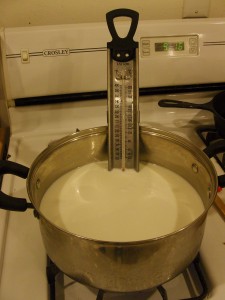

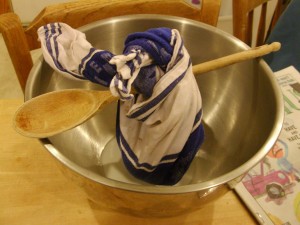
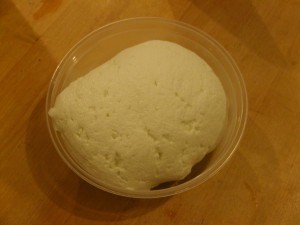
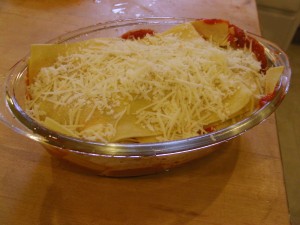
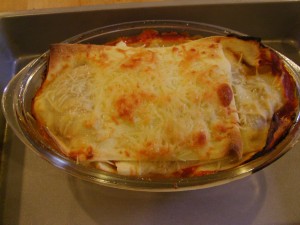
Your lasagna *looks* beautiful. I wish I didn’t have an enormous aversion to the flavor of goat’s milk. You must get your enjoyment of it from Daddy. I can do cow and sheep but not not not goat. It is visceral and immutable. Sigh.
Goat cheese is certainly divisive. John Hodgman is apparently not a fan either (or at least knows a lot of non-fans). At his show the other night, he suggested keeping goats after the apocalypse, because you can milk them “and make cheese nobody wants to eat.” 😉 I enjoy the flavor, but there are certainly other things I can’t get past flavor wise (mushrooms, olives…), so I understand…
If somebody else makes it, I’d be more than willing to try it and enjoy it!
Look forward to your becoming a Caliornian!
Love, Marie
I hope to feed you lots of homemade goodies when I am a Californian! Love you too!